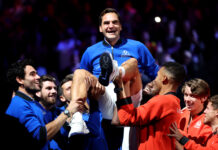Finding the man behind the Martian from Murcia
Michael Mewshaw
The story of Carlos Alcaraz’s rocket-burst arrival at the top of the ATP rankings – at 20 he’s the youngest man to achieve that goal – has hardened like Hollywood Boulevard’s Sidewalk of the Stars. According to most reports, the handprints of those who supposedly shaped his game seem set in stone. His grandfather established a modest tennis club on the scruffy outskirts of Murcia, Spain. His father, also named Carlos, picked up the game there and became a nationally ranked player. His son, known by the diminutive Carlitos, was soon better than his father. Impressed by the kid’s precocious talent, and by the fact that he came from an improbable place, people called him the Martian from Murcia.
A local entrepreneur, a manufacturer of dessert sweets, Alfonso Lopez Rueda, took an interest in the boy and financed his first trip outside of Spain to the under-10 world championship in Croatia. At 13, Carlitos signed a contract with IMG. A few years later Juan Carlos Ferrero, former world No. 1, became his coach, and the young prospect trained at Ferrero’s academy outside of Valencia.
Still his roots remained in the arid region of southeast Spain, not in Murcia itself, but outside the city in El Palmar. Always described as a village, suggesting cobbled streets and whitewashed houses, El Palmar is actually a sterile suburb of shops and apartment blocks. I traveled there to meet a man who played a major role in Alcaraz’s success, the coach who trained him and traveled with him for almost a decade, and was then air-brushed out of the glossy picture.
Kiko Navarro still works at the Alcaraz family’s club, and on a cold, rain-spattered afternoon he patted balls back and forth with a gaggle of kids. He agreed to an interview, but first had to finish giving lessons.
I waited in the club cafeteria with my friend and translator, Pedro Sulé Tavira. Two lifesize cardboard cutouts of Carlitos kept us company. They were ads for a meat company that declared: “Your values are ours.” Included in the list of Carlos’s values were what he maintains are the keys to his success: cabeza, corazón, cojones. Head, heart and balls.
A burly bearded guy with sad eyes, Kiko lumbered over to our table. He explained that he’d grown up at the club. His father had worked here, and with unlimited access to the courts, he developed into a promising junior. But his family lacked the money to pay for travel to tournaments. So, to stay in the game he loved, Kiko started coaching.
From the beginning, Carlitos was his star pupil, destined for greatness. He was small and thin and spent hours in the gym packing on muscle. But his speed and hand-eye coordination came naturally. Technically, Kiko insisted, Carlos was more advanced than Rafa at the same age.

What truly set him apart, however, was his attitude, his enthusiasm. Defeats didn’t discourage him. He never feared older or bigger players. By the time he was 15, Toni Nadal judged that Alcaraz’s forehand was among the five best in the world.
Because Mr. Alcaraz had his tennis club to run and other children to raise, Kiko became Carlitos’s primary coach. He said the chemistry between them was extraordinary. “I was stricter with Carlitos than his father. I didn’t allow him to have a cellphone or to waste time with video games.”
I interrupted to ask why he was back to coaching kids rather than traveling the tour with Carlitos. “I didn’t like that life,” Kiko said, “in the fast lane, in the limelight.”
Was it his choice to quit coaching Carlos?
Kiko paused before answering. “I would never say anything bad about Carlitos or his family. He’s like my brother, my son.”
“But now he’s with Ferrero. How does that make you feel?”
Again Kiko paused before repeating that he had nothing bad to say. He just stressed that by the time Ferrero took over, Carlos was already a finished product.
Kiko claimed he’d had other offers to coach on the tour. But having trained a player of exceptional talent, he couldn’t conceive of working with anyone else. I didn’t have the heart to ask whether he feared he would develop another champion only to lose him.
As I left El Palmar, I passed a building that had on its façade an abstract mural of Alcaraz smacking a backhand. The picture resembled an explosion in a shingle factory. Pieces of Carlitos and his racket seemed scattered everywhere. It wasn’t easy to fit them together, no more than it was easy to comprehend the arc of Alcaraz’s childhood. Was it a story about the birth of a star? Or also the death of another man’s dream?
Michael Mewshaw is the author of 23 books, including the recently published memoir, My Man in Antibes: Getting to Know Graham Greene.



















